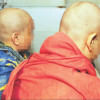The Two-finger Test: It only adds insult after trauma

This last instalment of the three-part series by Bishakha Devnath sheds some light on evidence collection and medical examination in rape cases.
If a rape victim is an adult woman or a mother, it is highly difficult for her to get justice because of the existing evidence law.
Already traumatised, she must undergo an examination called “two-finger” test that is neither scientific nor conclusive, experts say.
The intrusive nature of the test means further humiliation for her.
Then there is the Evidence Act, 1872. It says, “Where a man is prosecuted for rape or an attempt to ravish, it may be shown that the alleged victim was generally of an immoral character.”
During the trial proceedings, the defence takes advantage of this act to question the moral character of the complainant.
In a 2011 case, a 14-year-old rape survivor claimed she had been raped multiple times by her father over the last three years.
The medical report cited “no sign of recent forceful sexual intercourse”. The defence told the Gazipur women and children repression prevention tribunal that the complainant had falsely implicated her father in the rape case, having been influenced by her lover, according to the copy of the judgment delivered on November 26, 2012.
However, the court observed that the victim was still a child and so sexual intercourse even with her consent would constitute rape under the Penal Code 1860 and the Prevention of Cruelty to Women Act 2000. Besides, the father had also given a confessional statement.
If the victim is an adult or married and if the medical report cites “she is habituated” as in the case mentioned above, the harassment only increases in court.
LEGAL AID AGENCIES' MOVE AGAINST THE TEST
The two-finger test, well-practiced in Bangladesh to determine rape, had been designed with a medieval mindset of the patriarchal society and it has been proved to be illogical and non-scientific, said Lelin Choudhury, a preventive medicine specialist and a member of Doctors for Health and Environment.
While conducting the test, a medical officer uses his or her index and middle fingers to check if the hymen of the victim is intact or torn, the laxity of her vagina and if there are signs of injuries on the vaginal wall.
This test may fail to ascertain if a victim, who is or had been sexually active, was subjected to forceful intercourse i.e. rape or not. Some women may not have a hymen since birth and some may lose it in sports or accidents, Lelin said.
However, courts rely heavily on the outcome of the test in delivering judgments, according to a 2015 study commissioned by the National Human Rights Commission.
Ali Akbar, who has been working as public prosecutor at the special tribunal-2, Dhaka, for the last eight years, said almost all the judgments were based on medical evidence.
“Not even 10 percent of the cases see conviction,” he said, adding it was because either the test result was inconclusive or no evidence of rape was produced.
When several NGOs challenged the examination process in 2013, the Supreme Court directed the government to form a committee to formulate guidelines for treating and examining victims of rape.
The guidelines submitted later had a suggestion that the test would be applied if necessary, without defining special cases. The NGOs, including BLAST and Ain O Salish Kendra, opposed this and submitted a review of the guidelines with suggestions from five forensic experts, said Sharmin Akter, senior staff lawyer of BLAST.
The experts stated that the test is not necessary in rape cases, she said, adding that the World Health Organization (WHO) is also against the test in examination of rape victims.
Nearly five years after the move, the issue still awaits a decision from the court.
Meanwhile, the flawed practice continues.
Rebeka, a mother of two children, claimed to have been raped on an October night in 2000 on her way back home. She said the accused gagged her before raping her.
In the judgment delivered on May 13, 2007, the High Court said, “The [Medical] Board failed to ascertain whether she was raped or not… such medical evidence has weakened the prosecution case.”
In another verdict in June 2009, the HC drew the attention to the absence of proof of rape in the medical reports and non-examination of the apparels of the 17-year-old victim who used to work as maid in the house of the accused.
It declared the 2004 conviction of the accused by the Nari-O-Shishu Nirjatan Daman Tribunal, Naogaon improper and unjust. And the girl was said to be of “easy virtue”.
This label of “easy virtue” was used in dismissing 60 percent of the cases recorded by the Bangladesh Legal Aid and Services Trust between 2000 and 2010, in which the defence used the evidence act to bend the trial in favour of the accused, according to a study by the legal aid organisation.
SEALING THE CRACKS
The trial of all the cases mentioned above didn't see any forensic evidence collection other than the two-finger test or virginity test of the victims, while all the courts involved pointed out non-collection of samples of evidence or non-examination [chemical] of the samples like attires of the victims at the time of the incidents.
DNA tests of victims and accused should be made mandatory in rape cases because even if it is proved that a girl or woman has been raped, it is more important to prove who committed the rape, said Kawser Ahmed, a Supreme Court lawyer who was one of the two writers of the NHRC study.
The report suggests conducting physical examination of the accused person, which is absent as of now in the country, in proving his culpability.
In some cases, marks of injury on the accused person caused by the victim's struggle may be seen linked to the rape.
A medical tool called speculum can be used to see injuries inside the female genital area, Lelin said.
But rights activists vehemently oppose hinting to a victim's previous sexual life in the medical report.
“Rape is not a question of morality or character of the victim. It is a crime... Therefore the victim's character is irrelevant just as it is in a case of murder,” said Sara Hossain, executive director of BLAST.
While forensic tests do their part, according to the NHRC study the investigation authority should meticulously collect “alternative evidence that may be used in a court in cases where medical evidence is not available.”

 For all latest news, follow The Daily Star's Google News channel.
For all latest news, follow The Daily Star's Google News channel. 








Comments